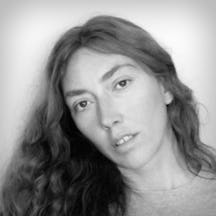Freediving is the act of swimming underwater, holding your breath, without breathing apparatus.

I grew up in Italy by the Mediterranean Sea with a sailor for a dad, so the sea is in my bones. The themes that I find recurrent in my work are water and an urge to capture the human body crystallised in movement. I always want to drag the audience underwater with me.
For ‘Under’ I filmed myself and other freedivers performing underwater; each film was shot on a single breath of air. It’s the first work where I performed myself, and that was a big challenge. We filmed at the Red Sea, but I don’t think you can tell that unless you are a freediver, because the blue intensity really changes from sea to sea.
The films in ‘Under’ explore the three elements which measure freediving: time, distance and depth. Time (freedivers call it ‘static’) is when you try and hold your breath for as long as you can and you just hang in the water completely still. Distance is when you try to swim as far as you can, and depth is when you try to dive as deep as you can, to the bottom of the sea. Depth is the biggest challenge because you add the element of the pressure of the water on your body and if you need to breathe you can’t just get out of the water.
We call this the free fall
During a deep dive your lungs shrink. When you go down first of all it’s very difficult: the first 5 metres of water really pushes you back up. Then it becomes a bit easier, and between 13 and 20 metres, depending on how salty the sea is, you start to fall a little bit like a stone. Not as fast as a stone, but a little bit like a stone; we call this the free fall. This is the moment when the freediver needs to stop moving completely. It’s very difficult because you want to go down quicker but if you move you consume more oxygen and then you have less oxygen to come back up, which is the difficult bit.
During the free fall you need to let go of everything that you know and everything that makes you feel good or bad. It’s a very liberating process, but equally you need to stay completely aware of your body and where you are. You are entirely in the moment. You enter a new space, a completely different dimension.
I remember the first times I started to push my limit a little longer underwater; it was like learning how to walk. Suddenly you hold back your craving to breathe and you think, “No, I don’t need to breathe for another 45 seconds. Dolphins don’t, why should I?” And then you reach another contraction and your cravings tell you, “You’ve got to breathe!” and you think, “I actually don’t. Maybe I can hold for another 10 seconds. Dolphins don’t…” I can only hold my breath for 3 minutes; I once did 4, but the women’s record is 9 minutes and the men’s 11 minutes.
It’s like being born again
Outside the water I’m trying, I pretend, I lie. In the water, I am. And that is the most beautiful aspect of freediving. I’ve never met a champion who said, “I want to be the deepest man in the world.” Every freediver I have met has told me, “I freedive because it makes me a better person.”
Some scientists think we are completely mad because we try to get as close to death and drowning as possible, and that is partly true. But I don’t think we’re getting closer to dying; instead, every time you take your first breath after a dive, it’s like your first breath. So for me it’s like being born again and the water is very much like being in the womb.
Kevin [physiologist Kevin Fong] is a scientist, he’s a broadcaster, and he is extremely passionate about what the human body can achieve. When I asked him to collaborate with me on ‘Under’ he said, “Yes, I am really interested because science hasn’t yet answered how we can switch from controlled breathing to uncontrolled breathing.”
The human body at its extreme
How do we switch? We can’t do that with any other vital organ. We can’t say, “Okay, now I will hold my heartbeat.” I love that something as simple and tangible as “hold your breath” is an issue that science can’t understand yet. With ‘Under’, Kevin and I really set up the platform for scientists and freedivers to collaborate. We went to Syracuse to interview Enzo Maiorca [1931–2016], who was the first freediver to go to 50 metres. When he did it he went completely against what every single scientist and freediver was telling him. Scientists told him he would die, but he did it anyway. It was a very emotional interview and really beautiful to see the young scientist meet the man who defied science. I would love science to help freedivers achieve even more, and for freedivers to help scientists research and understand more about breath-holding and the human body at its extreme.
'Under' is part of the Somewhere in Between exhibition, which is open 8 March 2018–27 August 2018.
About the contributors
Martina Amati
Martina Amati is a film-maker and artist based in London. Many of her films study the human body crystallised in movement, and the limits of its strength and fragility. She grew up close to the sea in Italy, and water is a recurring theme in her work. In 2010 she was awarded a BAFTA for her short film about holding your breath underwater, ‘I Do Air’. She received a Wellcome Arts Award in 2012 to create ‘Under’.
